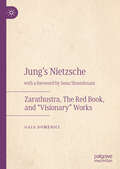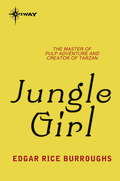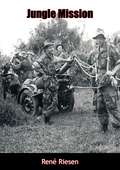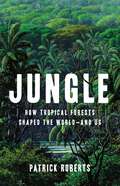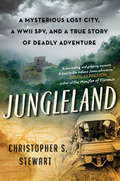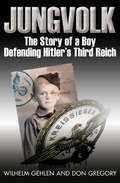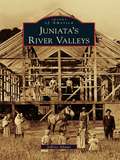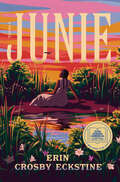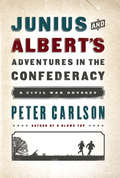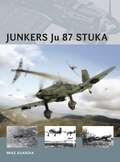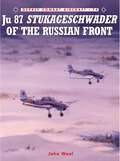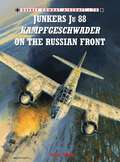- Table View
- List View
Jung and Christianity: The Challenge of Reconciliation
by Wallace B. CliftA parish minister attempts to answer the challenge presented to Christianity in the last decade of Jung's life--to make the teachings real in this day and age, and offer true enlightenment of the soul.
Jung and Educational Theory (Educational Philosophy and Theory Special Issues #34)
by Inna SemetskyJung and Educational Theory offers a new take on Jung’s work, providing original, rich and informative material on his impact on educational research. Explores Jung’s writing from the standpoint of educational philosophy, assessing what it has to offer to theories of education Highlights Jung’s emphasis on education’s role in bringing up integrated and ethical human beings Offers the perspectives of a diversity of academics and practitioners, on topics ranging from the role of the unconscious in learning to the polytheistic classroom Both a valuable addition to the academic library and a significant new resource in the professional development of teachers
Jung on Ignatius of Loyola’s Spiritual Exercises: Lectures Delivered at ETH Zurich, Volume 7: 1939–1940 (Philemon Foundation Series #27)
by C. G. JungJung&’s lectures on the psychology of Jesuit spiritual practice—unabridged in English for the first timeBetween 1933 and 1941, C. G. Jung delivered a series of public lectures at the Swiss Federal Institute of Technology (ETH) in Zurich. Intended for a general audience, these lectures addressed a broad range of topics, from yoga and meditation to dream analysis and the psychology of alchemy. Here for the first time are Jung&’s complete lectures on Ignatius of Loyola&’s Spiritual Exercises, delivered in the winter of 1939–1940.These illuminating lectures are the culmination of Jung&’s investigation into traditional forms of meditation and their parallels to his psychotherapeutic method of active imagination. Jung presents Loyola&’s exercises as the prime example of a Christian practice comparable to yoga and Eastern meditation, and gives a psychological interpretation of the visions depicted in the saint&’s autobiographical writings. Offering a unique opportunity to encounter the brilliant psychologist as he shares his ideas with the general public, the lectures reflect Jung&’s increasingly positive engagement with Roman Catholicism, a development that would lead to his fruitful collaborations after the war with eminent Catholic theologians such as Victor White, Bruno de Jésus-Marie, and Hugo Rahner.Featuring an authoritative introduction by Martin Liebscher along with explanations of Jungian concepts and psychological terminology, this splendid book provides an invaluable window on the evolution of Jung&’s thought and a vital key to understanding his later work.
Jung's Nietzsche: Zarathustra, The Red Book, and “Visionary” Works
by Gaia DomeniciThis book explores C.G. Jung's complex relationship with Friedrich Nietzsche through the lens of the so-called 'visionary' literary tradition. The book connects Jung's experience of the posthumously published Liber Novus (The Red Book) with his own (mis)understanding of Nietzsche's Zarathustra, and formulates the hypothesis of Jung considering Zarathustra as Nietzsche's Liber Novus –– both works being regarded by Jung as 'visionary' experiences. After exploring some 'visionary' authors often compared by Jung to Nietzsche (Goethe, Hölderlin, Spitteler, F. T. Vischer), the book focuses upon Nietzsche and Jung exclusively. It analyses stylistic similarities, as well as explicit references to Nietzsche and Zarathustra in Liber Novus, drawing on Jung's annotations in his own copy of Zarathustra. The book then uses Liber Novus as a prism to contextualize and understand Jung's five-year seminar on Zarathustra: all the nuances of Jung's interpretation of Zarathustra can be fully explained, only when compared with Liber Novus and its symbology. One of the main topics of the book concerns the figure of 'Christ' and Nietzsche's and Jung's understandings of the 'death of God.'
Jungle Girl
by Edgar Rice BurroughsAsia, vast continent of ancient civilizations and mysterious peoples, has many corners little known to the rest of the world. One such was the jungle-hidden heart of exotic Cambodia, where Gordon King, a daring American explorer, stumbled upon the thousand-year secret kingdom of THE LAND OF HIDDEN MEN. Edgar Rice Burroughs, whose Tarzan tales have enthralled millions, has written a novel of another such jungle hero that is as exciting, as adventure-packed and as imaginative as his best. The dangers Gordon King faced, his rescue of a jungle princess, and his combat against the perils of the lost city of Pnom Dhek are first-rate Burroughs to the last exciting line.
Jungle Heat
by Bonnie DeeCongo Free State, 1888On a mission deep in the jungle, Oxford anthropologist James Litchfield comes face-to-face with a local legend: a wild man who wanders with mountain gorillas and lives as one of their own.The chance encounter with the savage, whom James calls Michael, leads to a game of observation and exploration. Their mutual curiosity turns to an attraction-one that Michael has never experienced and James is desperate to deny.When members of the expedition unearth James's secret discovery-a living specimen of man at his most primitive-Michael becomes a pawn in their quest for fame.As their relationship deepens, James is compelled to protect Michael from the academics who would treat him as nothing more than a scientific acquisition and London society, which threatens to destroy their passionate bond...85,000 words
Jungle Man: The Autobiography Of Major P. J. Pretorius C.M.G. D.S.O. and Bar
by Field-Marshall J. C. Smuts Major P. J. PretoriusThe true story of Major Jan Pretorius, a South African elephant hunter and adventurer, this is a true tale of continuous adventure for a lifetime and considered one of the most extraordinary ever written. Pretorius also gives the first full account of the search for the German cruiser Königsberg which had sunk the Pegasus at Zanzibar and then gone into hiding in the Rufiji delta."I have never seen a more thrilling story of a hunter's life. It is full of almost unbelievable incidents, of reckless daring, and of hair-breadth escapes. If one knew the writer the interest increases, for he was a quiet, gentle, unassuming person in appearance. What fire lay hidden under those quiet features and that gentle manner! His very person seemed to be a camouflage."--Foreword by J. C. Smuts
Jungle Mission
by René RiesenJungle Mission is a poignant account of René Riesen’s life and mission during the First Indochina War amongst the Montagnards, and his ever growing love for these people by going native, learning their language, their traditions, their rituals, and their way of life.During World War II, Riesen worked briefly for the Vichy government and, following liberation, received a 20-year prison sentence. He volunteered to serve in the “BILOM” (Bataillon Leger d’Infanterie d’Outre-Mer), where WWII political prisoners could redeem themselves.Arriving in Saigon in May 1950 as a Colonial Infantry “2eme Classe” soldier affected to the BILOM—which by then had ceased to exist and most of its soldiers assigned to the BMEO (“Bataillon de Marche Extreme Orient”) created in January 1950—Riesen was assigned to the 1st Company, 4th BMEO at the outpost of Kon Plong, controlling access to the coastal plains of Son Ha and Ba To; this post was located about a day’s travel away from Kontum, positioned on a 1,800m high peak, where the rainy season lasted about seven months, with thick fog present almost every day.In December 1950, the 4th BMEO was renamed to the 4th Montagnard battalion, and its HQ remained at Ban Mé Thuot whilst its Battalions operated around Kontum. Riesen would go on to serve four years in the Kontum area and joined the GCMA after its formation, serving under Captain Hentic (“L’action Hre”).For his services in French Indochina, Corporal Riesen was awarded the French Croix de Guerre, the Croix des T.O.E (Théâtres d’opérations extérieures) and the Croix de la Vaillance Vietnamienne, with palm for his actions in French Indochina.As with many others, following his tour in Indochina Riesen was sent to the much quieter operational theatre of Algeria; however, this area too did not remain peaceful for long, escalating quickly into full warfare, and Riesen and his wife died during an ambush by Arabs in December 1956.
Jungle Rules: A True Story of Marine Justice in Vietnam
by Charles HendersonA true story of murder, justice, and the military from the author of Marine Sniper, the Vietnam classic with more than a million copies in print. <P> In Vietnam, they're known as "Jungle Rules"- those by which the U.S. military tries to keep control, often allowing inconvenient facts and regulations to conveniently slip between the cracks. This is the battlefield Captain Terry O'Connor of the JAG Corps is stepping onto. <P> There's been a murder. After a long day on patrol, Private Celestine Anderson returned to base, only to come under fire from a group of racist white marines. He finally snapped, killing one of his tormentors-and now the inexperienced O'Connor must defend him. But the case pulls O'Connor into the heart of the Vietnam conflict, where bullets overrule books and death is the only judge of men.
Jungle Soldier: The true story of Freddy Spencer Chapman
by Brian MoynahanArctic explorer, survival expert and naturalist Freddy Spencer Chapman was trapped behind enemy lines when the Japanese overran Malaya in 1942. His response was to begin a commando campaign of such lethal effectiveness that the Japanese deployed an entire regiment against him, hunting for him as they did for no other. He was wounded, and racked by tropical disease. His companions were killed, or captured and then beheaded. Cut off from friendly forces, his only shelter the deep jungle, Chapman held out for three years and five months. Jungle Soldier recounts the thrilling and unforgettable adventures of the north country orphan who survived against all odds to become a legend of guerrilla warfare.
Jungle Tales of Tarzan (TARZAN)
by Edgar Rice BurroughsThe young Tarzan was unlike the great apes who were his only companions and playmates. Theirs was a simple, savage life, filled with little but killing or being killed. But Tarzan had all of a normal boy's desire to learn. He had painfully taught himself to read from books left by his dead father. Now he sought to apply this book knowledge to the world around him. He sought for such things as the source of dreams and the whereabouts of God. And he searched for the love and affection that every human being needs. But he was alone in his struggles to grow and understand. The life of the jungle had no room for abstractions.
Jungle Wife
by Sasha SiemelJungle Wife, first published in 1949, is the warm-hearted story of a Philadelphia woman who married a professional hunter and sportsman, Sasha Siemel (1890-1970) and raised a family in the wilds of the Brazilian state Mato Grosso. Sasha met his future wife, Edith Bray Siemel (1919-2012), in Philadelphia while on a lecture tour, and moved together to Brazil where they raised their three young children. The family's many adventures are described in the book. Later, the couple returned to the U.S. and settled on a farm in southeastern Pennsylvania. Included are 2 maps and 8 pages of photographs.
Jungle of Stone: The True Story of Two Men, Their Extraordinary Journey, and the Discovery of the Lost Civilization of the Maya
by William Carlsen"Thrilling. ...A captivating history of two men who dramatically changed their contemporaries' view of the past." -- Kirkus (starred review)In 1839 rumors of extraordinary yet baffling stone ruins buried within the unmapped jungles of Central America reached two of the world's most intrepid travelers. Seized by the reports, American diplomat John Lloyd Stephens and British artist Frederick Catherwood--each already celebrated for their adventures in Egypt, the Holy Land, Greece, and Rome--sailed together out of New York Harbor on an expedition into the forbidding rainforests of present-day Honduras, Guatemala, and Mexico. What they found would re-write the West's understanding of human history.In the tradition of Lost City of Z and In the Kingdom of Ice, former San Francisco Chronicle journalist and Pulitzer Prize finalist William Carlsen reveals the unforgettable true story of the discovery of the ancient Maya. Enduring disease, war, and the torments of nature and terrain, Stephens and Catherwood meticulously uncovered and documented the remains of an astonishing civilization that had flourished in the Americas at the same time as classic Greece and Rome--and had been its rival in art, architecture, and power. Their remarkable book about the experience, written by Stephens and illustrated by Catherwood, became a sensation, hailed by Edgar Allen Poe as "perhaps the most interesting book of travel ever published" and recognized today as the birth of American archeology. Most importantly, Stephens and Catherwood were the first to grasp the significance of the Maya remains, recognizing that their antiquity and sophistication overturned the West's assumptions about the development of civilization.By the time of the flowering of classical Greece (400 B.C.), the Maya were already constructing pyramids and temples around central plazas. Within a few hundred years the structures took on a monumental scale that required millions of man-hours of labor, technical and organizational expertise. Over the next millennium dozens of city-states evolved, each governed by powerful lords, some with populations larger than any city in Europe at the time, and connected by road-like causeways of crushed stone. The Maya developed a cohesive, unified cosmology, an array of common gods, a creation story, and a shared artistic and architectural vision. They created dazzling stucco and stone monuments and bas reliefs, sculpting figures and hieroglyphs with refined artistic skill. At their peak, an estimated ten million people occupied the Maya's heartland on the Yucatan Peninsula, a region where only half a million now live. And yet, by the time the Spanish reached the "New World," the classic-era Maya had all but disappeared; they would remain a mystery for the next three hundred years.Today, the tables are turned: the Maya are justly famous, if sometimes misunderstood, while Stephens and Catherwood have been all but forgotten. Based on Carlsen's rigorous research and his own 2,500-mile journey throughout the Yucatan and Central America, Jungle of Stone is equally a thrilling adventure narrative and a revelatory work of history that corrects our understanding of the Maya and the two remarkable men who set out in 1839 to find them.
Jungle: How Tropical Forests Shaped the World—and Us
by Patrick Roberts"A bold, ambitious and truly wonderful history of the world"—Peter Wohlleben, author of The Hidden Life of TreesFrom the age of dinosaurs to the first human cities, a groundbreaking new history of the planet that tropical forests made. To many of us, tropical forests are the domain of movies and novels. These dense, primordial wildernesses are beautiful to picture, but irrelevant to our lives. Jungle tells a different story. Archaeologist Patrick Roberts argues that tropical forests have shaped nearly every aspect of life on earth. They made the planet habitable, enabled the rise of dinosaurs and mammals, and spread flowering plants around the globe. New evidence also shows that humans evolved in jungles, developing agriculture and infrastructure unlike anything found elsewhere. Humanity&’s fate is tied to the fate of tropical forests, and by understanding how earlier societies managed these habitats, we can learn to live more sustainably and equitably today. Blending cutting-edge research and incisive social commentary, Jungle is a bold new vision of who we are and where we come from.
Jungleland: A Mysterious Lost City, a WWII Spy, and a True Story of Deadly Adventure
by Christopher S. Stewart“A bold attempt to solve the mystery of the White City of Honduras. . . . Readers who loved The Lost City of Z have found their next great true adventure.” —Mitchell Zuckoff, New York Times–bestselling author of Lost in Shangri-LaOn April 6, 1940, explorer and future World War II spy Theodore Morde—who would one day attempt to assassinate Adolf Hitler—was anxious about the perilous journey that lay ahead of him. Deep inside “the little Amazon,” the jungles of Honduras’s Mosquito Coast—one of the largest, wildest, and most impenetrable stretches of tropical land in the world—lies the fabled city of Ciudad Blanca: the White City. For centuries, it has lured explorers, including Spanish conquistador Herman Cortes. Some intrepid souls got lost within its dense canopy; some disappeared. Others never made it out alive. Then, in 1939, Theodore Morde claimed that he had located this El Dorado-like city. Yet before he revealed its location, Morde died under strange circumstances, giving credence to those who believe that the spirits of the Ciudad Blanca killed him.In Jungleland, journalist Christopher S. Stewart seeks to retrace Morde’s steps and answer the questions his death left hanging. Is this lost city real or only a tantalizing myth? What secrets does the jungle hold? What continues to draw explorers into the unknown jungleland at such terrific risk? In this absorbing true-life thriller, Stewart sets out to find answers—in a white-knuckle adventure that combines Morde’s wild, enigmatic tale with his own epic journey to discover the truth about the White City.“A gritty, remarkable tale of exploration and risk in a nervy trek to the edge of civilization.” —Publishers Weekly (starred review)“Stewart is a crisp, lean, colorful stylist, with that essential knack: a nose for punchy, telling anecdotes and images . . . great fun to read.” —Salon“A fascinating and gripping account, a true-to-life Indiana Jones adventure.” —Douglas Preston, New York Times–bestselling author of The Lost City of the Monkey God
Jungvolk: The Story of a Boy Defending Hitler's Third Reich
by Wilhelm Gehlen Don Gregory&“An extraordinary account of a young boy caught up in the middle of a war . . . frank and even funny at times . . . utterly absorbing&” (Books Monthly). This is the wartime memoir of a boy named Will, who happened to be the nephew of the head of Nazi Germany&’s intelligence agency. The author, only ten years old when the war began, became a helper at the local Luftwaffe flak battery, fetching ammunition. It was exciting work for Will, a member of the &“Jungvolk,&” and by the end of the war, he had become expert at judging attacks. As fighter raids increased in frequency, he noted that the pilots became less skilled. Gehlen&’s town was repeatedly bombed, and he often had to help with the wreckage or to pull survivors from basements. He witnessed more death than a child ever should; nevertheless, his flak battery continued firing until US tanks were almost on top of the position. In this book, Gehlen provides an intimate glimpse of the chaos, horror, and black humor of life just behind the front lines. As seen through the eyes of a child who was expert in aircraft identification and bomb weights, food-rationing and tank types, one encounters a view of life inside Hitler&’s wartime Reich that is both fascinating and rare. &“Although the memories Gehlen shares are narrow, and offer little insight into the Reich itself, they&’re remarkable for the child&’s perspective they bring to bear on a warring country&’s ferocious struggle.&” —Publishers Weekly &“A real gem, a quiet tour de force . . . Despite its serious subject matter the book reads as an adventure story from start to finish.&” —Military Modelling
Juniata's River Valleys
by Jeffrey AdamsThe valleys of the Juniata River occupy the very heart of the state of Pennsylvania. This ecosystem is a substantial contributor to the great Chesapeake watershed that drains a major portion of the continent. Ancient Native American pathways along the Juniata gave way to an early turnpike and soon welcomed a canal. With much fanfare, the Pennsylvania Railroad chose the Juniata Valley as the choice route to unify the state. The land that provided iron, lead, and pure silica sand at the start of the Industrial Revolution today provides hiking trails. The waterways that once hauled grain to market are now a destination for millions each year seeking relaxation and recreation. Through vintage photographs and images culled from albums and attics, Juniata's River Valleys lends a glimpse at life in earlier times along one of America's most spectacular waterways.
Junie: A Novel
by Erin Crosby EckstineGOOD MORNING AMERICA BOOK CLUB PICK • A young girl must face a life-altering decision after awakening her sister&’s ghost, navigating truths about love, friendship, and power as the Civil War looms.&“The richly textured prose quickly pulled me into [Junie&’s] treacherous yet magical world.&”—Charmaine Wilkerson, New York Times bestselling author of Black CakeSixteen years old and enslaved since she was born, Junie has spent her life on Bellereine Plantation in Alabama, cooking and cleaning alongside her family, and tending to the white master&’s daughter, Violet. Her daydreams are filled with poetry and faraway worlds, while she spends her nights secretly roaming through the forest, consumed with grief over the sudden death of her older sister, Minnie.When wealthy guests arrive from New Orleans, hinting at marriage for Violet and upending Junie&’s life, she commits a desperate act—one that rouses Minnie&’s spirit from the grave, tethered to this world unless Junie can free her. She enlists the aid of Caleb, the guests&’ coachman, and their friendship soon becomes something more. Yet as long-held truths begin to crumble, she realizes Bellereine is harboring dark and horrifying secrets that can no longer be ignored.With time ticking down, Junie begins to push against the harsh current that has controlled her entire life. As she grapples with an increasingly unfamiliar world in which she has little control, she is forced to ask herself: When we choose love and liberation, what must we leave behind?
Juniper and Anise
by Marion L CornettHulda Pearl Rosenkowski chose to survive, no matter the consequences. Poland may have been her homeland, but when murderous scavengers kill her mama and dear father, and brother Josef, during a raid on their house, she finds a way to escape. Unharmed physically but damaged forever, Hulda arrives in America with only the clothes on her back and a tattered potato bag containing a few scarce coins and precious family jewels. Dreams of becoming a "flapper" girl and brushes with members of the Detroit Purple Gang dominate Hulda's life as she counts down dwindling reserves, takes care of a broken-down farmhouse, a baby, and hides a secret that could land her in prison. Years later, as told through the eyes of small-town sheriff Claude Calkins, a story of rum-running and bootleggers stealing away in the dead-of-night with stashes of bathtub gin emerges and changes a young girl's life forever.
Junius and Albert's Adventures in the Confederacy: A Civil War Odyssey
by Peter CarlsonJunius Browne and Albert Richardson covered the Civil War for the New York Tribune until Confederates captured them as they tried to sneak past Vicksburg on a hay barge. Shuffled from one Rebel prison to another, they escaped and trekked across the snow-covered Appalachians with the help of slaves and pro-Union bushwhackers. Their amazing, long-forgotten odyssey is one of the great escape stories in American history, packed with drama, courage, horrors and heroics, plus moments of antic comedy. On their long, strange adventure, Junius and Albert encountered an astonishing variety of American charactersuAbraham Lincoln and Ulysses S. Grant, Rebel con men and Union spies, a Confederate pirate-turned-playwright, a sadistic hangman nicknamed othe Anti-Christ, OCO a secret society called the Heroes of America, a Union guerrilla convinced that God protected him from Confederate bullets, and a mysterious teenage girl who rode to their rescue at just the right moment. Peter Carlson, author of the critically acclaimed "K Blows Top," has, in "Junius and AlbertOCOs Adventures in the Confederacy," written a gripping story about the lifesaving power of friendship and a surreal voyage through the bloody battlefields, dark prisons, and cold mountains of the Civil War.
Junkers Ju 87 Stuka
by Mike GuardiaIn the opening days of Nazi Germany's Blitzkrieg campaigns, few aircraft could invoke as much terror as the Junkers Ju 87. Nicknamed the "Stuka" (an abbreviation of Sturzkampfflugzeug - the German term for "dive-bomber"), the Ju 87 was perhaps the most feared tactical bomber of the ETO. With its fixed landing gear and inverted gull wings, the Stuka was easily one of the most recognizable aircraft of the Blitzkrieg era. Although a sturdy and reliable dive-bomber, the Stuka's effectiveness was largely psychological in nature. Its dive-activated air siren produced a dreadful wail - which could incite panic in even the most disciplined of enemy ground units. However, the Stuka's effectiveness waned during the later years of the war. Lightly armored and ill-suited for air combat maneuvering, the Stuka was easy prey for Allied fighters. This title follows the Ju 87 from its development and early deployment through its operational history in the skies over Europe.
Junkers Ju 87 Stukageschwader 1937-41
by Mike Chappell John WealThe Ju 87 Stuka was the most feared weapon in the German arsenal in the first year of World War II (1939-1945), the Luftwaffe using it to deadly effect during the Blitzkrieg between September 1939 and June 1940. Although vulnerable to the enemy fighters due to its moderate speed in level flight and general lack of manoeuvrability, the Ju 87 nevertheless soon came to symbolise the might of Nazi Germany as the mere handful of Stukageschwader supporting the Wehrmacht rampaging out of the Fatherland took a heavy toll of the Allied forces.
Junkers Ju 87 Stukageschwader of the Russian Front
by John WealThis final volume of the Osprey trilogy on the infamous Luftwaffe dive-bomber charts its fortunes in the toughest theater of all: the Eastern Front. The fearsome reputation that the Stuka had enjoyed in the opening months of World War II (1939-1945) was shattered over the English Channel in the summer of 1940 but was restored in the invasion of the Soviet Union. Against a demoralized enemy, the Ju 87 scored a string of spectacular successes, destroying infantry, artillery and armor alike and sinking numerous ships of the Soviet Baltic Fleet. In the far north one Stukagruppe concentrated on bombing the Arctic port of Murmansk and disrupting rail traffic down into the Russian hinterland. However, as the Soviet Union slowly gathered strength, the Stuka units found themselves outnumbered, outfought, and relegated to operating under cover of darkness. The days of the dive-bomber were finally over. The Schlacht, or ground-attack, aircraft now ruled the skies above the battlefields.
Junkers Ju 88 Kampfgeschwader in North Africa and the Mediterranean
by John WealThis volume follows the Luftwaffe's twin-engined Wunderbomber southwards to describe its deployment in North Africa and the Mediterranean Theater during World War II (1939-1945), from the Straits of Gibraltar in the west, via the beleaguered island of Malta, to the Aegean and the Suez Canal in the east. It is a story of two distinct parts - the initial lightning successes, and then the long, slow process of retreat and defeat. It began early in 1941 with the first sporadic air raids on Malta, followed in the spring by the campaign in the Balkans which resulted in the conquests of Yugoslavia, Greece and Crete. After supporting land operations in North Africa during the latter half of 1941, the Ju 88s resumed their assault on Malta. Such was their decline, however, that by the final month of the war there was just one machine left in the Mediterranean - an improved model Ju 188, which was used to drop Axis agents behind the Allied lines in Italy. Bringing the story to life are personal accounts of some of the more famous actions - the bombing of the evacuation shipping off the coast of Greece and the sinking of three Royal Navy destroyers south of Crete by the renowned 'Helbig Flyers' of LG 1, all illustrated with rare photographs and full color profiles.
Junkers Ju 88 Kampfgeschwader on the Russian Front
by John WealCompleting Osprey's triliogy on the Ju 88 Kampfgeschwader this new volume focuses on activities on the Eastern Front during World War II (1939-1945). Comprising the main punch of the Luftwaffe's bomber arm during the initial invasion of the Soviet Union, the Ju 88 participated in a number of early strategic bomber raids on Moscow before assuming responsibility for supporting the Wehrmacht's ground forces in the field. In this role, the Ju 88s attacked bridges, road and rail communications, and troop concentrations and gave rise to many individual incidents that contribute to a varied and interesting narrative. Along with this main narrative, the book also covers the role the Ju 88s played in attacking the artic convoys that were shipping allied war supplies to Russia, and the several variant models that were employed. The strangest of these was a Ju 88 packed with explosives and guided by a fighter clipped onto its back that was used as a giant bomb against the Russians as they were approaching Berlin late in the war.



